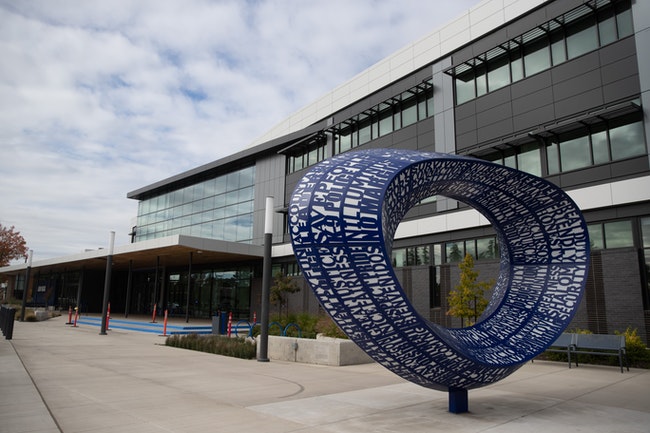 Salem Police headquarters on Friday, Oct. 8, 2021. (Amanda Loman/Salem Reporter)
Salem Police headquarters on Friday, Oct. 8, 2021. (Amanda Loman/Salem Reporter)
The Salem Police Department is turning to the public for feedback on how it should steer its priorities and use data to track its crime response.
Chief Trevor Womack said he hopes the three-year “strategic plan” will provide focus for a department he says is understaffed and has had to scale back community engagement efforts to handle basic emergency calls as the city has grown.
“We started to cut these things at the expense of our community engagement and relationships with the community just so we could handle basic emergency response, and that’s where we are today,” he said. “If we want to spend time, invest time, in building relationships, it’s going to take more staff.”
Details of the plan won’t be public until December when Salem police will present an overview to the city council, and the department will release the final draft to the public by Jan. 22, Womack said at an Oct. 5 press briefing.
A public survey will be available through Oct. 24. The department will spend November drafting the plan.
Local civil rights group leaders say the idea comes at a low point for public trust in Salem area law enforcement, particularly among people of color.
Reginald Richardson, president of the Salem-Keizer NAACP, said a Tuesday meeting with Womack left him disappointed and doubtful that the chief intends to engage the community, or that Womack can impartially review the work of his department.
“We think the strategic plan is a farce,” Richardson said.
When Richardson took over as branch president in January, he said he expressed concerns to Womack about the presence of hate groups at rallies, and how police have sometimes responded in riot gear to Black Lives Matter protests while doing little when armed Proud Boys gathered in public places.
“He was supposed to sort of do an assessment and get back to us. That never happened. And we haven’t felt like he’s tried to engage us,” Richardson said. “I’m frankly not willing to continue to waste time and to subject my members to the racist inadequacies of this department.”
Richardson said the local NAACP branch had a longstanding relationship with the previous chief, Jerry Moore and deputy chief George Burke, who they will continue to meet with regularly. “But we are done with the police chief,” he said.
Salem police spokesman Lt. Treven Upkes said deputy Chief George Burke regularly attends meetings held by the local branch NAACP, and that the Tuesday meeting between Richardson and Womack “reaffirms that our work is not done.”
“We remain open to engagement with all members of our community, including members of the NAACP, and hope that future dialogue will be productive for all involved,” Upkes said.
“We know and understand there is much work to be done in building trust, especially with our minority communities,” Upkes said. “The challenged history between law enforcement and minority communities cannot be resolved in a single meeting. We believe our strategic plan will help guide our trust-building efforts over the next three years and begin moving the needle in the right direction”
The plan will also draw from the findings and recommendations from an independent audit of the department by Chicago-based security risk management firm Hillard Heintze released in March. The Salem City Council voted to move forward with the outside performance audit in July 2020 following racial justice protests in which Salem police were accused of uneven treatment of Black Lives Matter protestors and armed right-wing groups like the Proud Boys.
The audit found that the department needs to create a formal plan on how it will police in the community, collaborate with nonprofits and social service agencies more and conduct a staffing survey. It also determined the department doesn’t use its data on calls for service to direct staffing.
Womack was hired as police chief last December, replacing longtime chief Moore.
The police department survey, which had 265 responses as of Monday, breaks questions down into three goal sections: safety, legitimacy and excellence. Each section lists different “objectives” and asks people to rank how important they find them on a scale from one to five, with other questions asking for any additional thoughts.
Womack said he hopes the survey will help guide police priorities.
“Maybe that means we focus on serious crimes like gun violence, child abuse, domestic violence and we create a more focused effort to be more effective in those areas,” he said. “Is that what the community wants out of the police department?”
Legitimacy, he said, means building trust in the community by reaching beyond groups and organizations that have established relationships with Salem police. “Some of the more difficult, challenging groups are folks who have a fear of the police or just feel like they haven’t had a voice at their police department,” he said. “We want to find out, how do we tap into those folks?”
The department’s policies are not currently available online, Womack said, and it is working to create a “transparency portal” to share its policies and other information with the public, including data around use of force, traffic stops and raw data for anyone who wants to analyze it to ensure it is reflected accurately.
Womack said he expects the department will start using body-worn cameras, which he said should be standard equipment for police, in the first half of 2022. The Salem City Council in June approved $816,400 in funding to cover the first year of implementing Salem police’s body-worn camera program, including equipment, data storage and four non-sworn employees to manage archiving the large amount of footage it’s expected to produce. After that, the cost is expected to drop to $630,000 annually.
The city of Salem’s annual community satisfaction survey released in August found that while a majority of the public was satisfied with police services, there were significant differences in levels of satisfaction among demographic and area groups. Residents age 65 and over, had the highest satisfaction at 79%, while those ages 30-44 reported the lowest at 58%.
The survey also found satisfaction with police increased this year among people of color and decreased among white residents. In 2020, 77% of white residents were satisfied with police, while 54% of of people of color were. 2021 data showed that gap narrowed to 72% satisfaction among white residents and 65% among people of color.
Levi Herrera-Lopez, executive director of Mano a Mano who serves on the city’s Community Policing Performance Audit Steering Committee, said the police department’s role in the community should be based on values dictated by the public. He added that he has heard repeatedly from community members that issues related to livability, namely the treatment of people with mental illness and the unhoused, are best addressed not as criminal matters.
Having lived in Salem since 1992, Herrera-Lopez said he has seen Salem police’s relationship with the community relations have ups and downs. “The ups, I would say, have never been that high,” he said. “I think this is one of the lowest that I’ve seen it.”
Herrera-Lopez said mistrust in communities of color with the department dates back to the late 1990s, when large migration from Southern California and other parts of the country with high gang activity spread the problem to metropolitan cities, including Salem.
“Rather than looking at inclusion and how to really address gang activity as a social problem, as a community problem and maybe even a family problem, it was immediately addressed in terms of criminal behavior,” he said. “Everything that we’ve not addressed over the last…almost 30 years just kind of has reached a boiling point.”
Casey Kopcho, an auditor with the Oregon Secretary of State’s Office who also serves on the audit steering committee, said Salem would benefit from having an independent city auditor that would review the police department’s actions.
Kopcho said that would be more effective – and less costly – than shelling out for a single independent assessment as the city did last year.
He said a strategic plan is useless unless it establishes specific, measurable goals with ways of tracking the department’s progress through data.
Kopcho also said the department should express public support for a crisis response program separate from police where mental health workers, not police, would respond to some crisis calls, which would go through 911 dispatch.
“Being willing to lean into that when it is uncommon for a police department, I think, would go a long way in engendering support from the community because it’s something that the community advocates for.”
The city of Salem recently paused its plans to start such a program, which was intended to run through United Way of the Mid-Willamette Valley and received broad support from Salem residents who testified as the city was planning its budget for the coming year. Nearly 100 people wrote to the budget committee asking members to recommend funding for a program and more than a thousand signed a petition.
But state funding needed for the program would have to first go through Marion County, and Marion County Undersheriff Jeff Wood said county officials didn’t want to pursue a program that overlapped with or didn’t complement existing crisis response services involving law enforcement.
Womack said at the briefing that there are gaps in Salem’s crisis response, but creating a program similar to CAHOOTS in Eugene without the right services and a place to take people in crisis would be a risk. He said he would support a non-police program for nonviolent crisis calls if it doesn’t require cutting staffing from the department’s budget.
Contact reporter Ardeshir Tabrizian: [email protected] or 503-929-3053.
JUST THE FACTS, FOR SALEM – We report on your community with care and depth, fairness and accuracy. Get local news that matters to you. Subscribe to Salem Reporter starting at $5 a month. Click I want to subscribe!
PRIOR COVERAGE:
Salem’s police chief talks about efforts to make inroads with the community
Independent audit finds Salem police need to better use data, create a community policing plan
Salem, United Way halt plans for mental health crisis responder program









